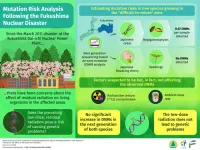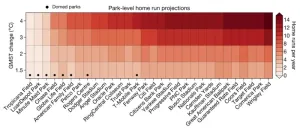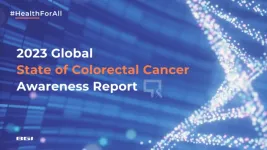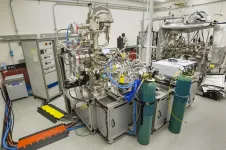(Press-News.org) CHAPEL HILL, N.C. – Glioblastoma is the most common type of brain tumor in adults. The disease is 100% fatal and there are no cures, making it the most aggressive type of cancer. Such a poor prognosis has motivated researchers and neurosurgeons to understand the biology of tumors with the goal of creating better therapies.
Dominique Higgins, MD, PhD, an assistant professor in the Department of Neurosurgery, has heeded the call. Higgins and a team of researchers at Columbia University have found that glioblastoma tumor cells are particularly sensitive to ferroptosis - a type of cell death that can be triggered by removing certain amino acids from the diet.
“First, we found that when we take away certain amino acids in animal models that the glioblastoma cells are more likely to die by ferroptosis,” said Dr. Higgins. “Secondly, we found that removing these amino acids makes our drugs a lot more effective at inducing ferroptosis in cancer cells.”
Their findings were published in Nature Communications.
Ferroptosis is an iron-dependent type of “programmed cell death” or a biological process that causes cells to “self-destruct” on command. Our bodies don't need to kill cells unless absolutely necessary, so the process is tightly controlled by certain biological mechanisms. However, researchers are only now beginning to comprehend the process because ferroptosis was recognized only a decade ago.
“The recent discovery of ferroptosis adds to the excitement of it all,” said Higgins, who is a member at the UNC Lineberger Comprehensive Cancer Center. “It is really a rapidly growing body of research, and we are finding that it’s a very important for a lot of biological processes, and not just in cancers.”
Every cell has certain safety features to keep it from going through ferroptosis in an unpredictable way. Two amino acids, cysteine and methionine, are critical for preventing the process from starting in cells. We typically pick up these amino acids through our diet.
Therefore, Higgins’ research team decided to focus their efforts on these components.
By depriving animal models of cysteine and methionine through a customized diet, they found that the glioblastoma cells were significantly more likely to die via ferroptosis. They also found that the diet made their chemotherapy drugs more apt at initiating programmed cell death, meaning that very low doses were able to achieve a more potent effect than before. Ultimately, the animal models had improved survival after going on the diet.
“Now, we need to find a way to eliminate those components through dietary needs, while still maintaining energetic requirements that a patient may have, especially a cancer patient, who has different requirements than the average patient,” said Higgins.
Having proven that the diet is effective in animal models, Higgins is working with colleagues at UNC Lineberger to develop a clinical trial for patients with glioblastoma. He plans to put patients on the diet prior to surgery to understand how it effects the body and the tumor. Once he removes the tumor from the brain, he will analyze it to see how well the tumors responded to the diet.
This type of diet has also shown to be very effective in sarcoma, lung cancers, and pancreatic cancers, so there is hope that this diet can be used to put some extra umph behind chemotherapy and/or surgery to remove tumors throughout the body.
Higgins is also working with Shawn Hingtgen, PhD, professor of pharmacoengineering and molecular pharmaceutics in the UNC Eschelman School of Pharmacy and associate professor in the Department of Neurosurgery, to study the brain’s response to treatment in a more natural setting.
Hingtgen is the overall grant PI for Project Brainslice, a multi-institutional effort to test neurological therapies using tumor samples grown on slices of brain tissue. Higgins maintained that this is a better way to study treatment response than simply observing it in a plastic dish.
Project Brainslice is just one of the many different research tools that researchers have at their fingertips here at UNC’s School of Medicine.
“We have a lot of different research tools unique to UNC, and it is one of the main reasons that I wanted to come to UNC,” said Higgins, who joined UNC Neurosurgery in the fall of 2022. “Just in terms of the ability to study a clinical problem in an accurate animal model, it is one of the few places in the country that has like an established setup to do that.”
END
Researchers leverage cell self-destruction to treat brain tumors
Dominique Higgins, MD, PhD, led research into how a specialized diet can induce a new type of programmed cell death to help kill brain tumor cells
2023-04-07
ELSE PRESS RELEASES FROM THIS DATE:
Deaths by suicide increase significantly during the week of a full moon
2023-04-07
INDIANAPOLIS—For centuries, people have suspected a full moon in the sky to cause mysterious changes in people. Now, psychiatrists at Indiana University School of Medicine have found deaths by suicide increase during the full moon.
“We wanted to analyze the hypothesis that suicides are increased during the period around full moons and determine if high-risk patients should be followed more closely during those times,” said Alexander Niculescu, MD, PhD.
Niculescu and his team looked at data from the Marion County coroner’s ...
How to make electronic noses smell better
2023-04-07
Imagine if you could ask a machine to “smell” something for you with just a click of a button. That’s what electronic noses, or e-noses, are for. They are systems that combine chemical gas sensors, signal processing and machine learning algorithms to mimic the sense of smell. E-noses can be used for many purposes, such as checking food quality, monitoring air pollution, diagnosing diseases and detecting explosives. How do they work? What are the challenges and opportunities in this field? A team led by Jingdong Chen of Northwestern Polytechnical University in Xi’an, China and ...
Study assesses risk of mutation due to residual radiation from the Fukushima nuclear disaster
2023-04-07
Ionizing radiation from nuclear disasters are known to be harmful to the natural environment. The Fukushima Dai-ichi Nuclear Power Plant meltdown that occurred in 2011 is a prominent example of such a disaster in recent memory. Even a decade after the incident, concerns remain about the long-term effects of the radiation. In particular, it is not clear how the residual low-dose radiation might affect living organisms at the genetic level.
The brunt of the disaster is usually borne by the floras inhabiting the contaminated areas since they cannot move. This, however, makes them ideal for ...
Simple but revolutionary modular organoids
2023-04-07
A team led by Masaya Hagiwara of RIKEN national science institute in Japan has developed an ingenious device, using layers of hydrogels in a cube-like structure, that allows researchers to construct complex 3D organoids without using elaborate techniques. The group also recently demonstrated the ability to use the device to build organoids that faithfully reproduce the asymmetric genetic expression that characterizes the actual development of organisms. The device has the potential to revolutionize the way we test drugs, and could also provide insights into how tissues develop and lead to ...
New book explores possibilities of colonizing planets, moons and beyond
2023-04-07
Dan Răzvan Popoviciu new book New Worlds: Colonizing Planets, Moons and Beyond (published by Bentham Science) explores the possibilities of transforming humanity into a multi-planetary species, while also sounding an alarm about our long-term future. It emphasizes the importance of efficiently using Earth's resources and expanding beyond the planet's borders.
In the book, Popoviciu discusses how various planets, moons, and asteroids in the Solar System can provide important resources and become potential new home worlds for humans. The author goes beyond simple colonization and discusses solutions for terraforming ...
Spike in major league home runs tied to climate change
2023-04-07
In the history of Major League Baseball, first came the low-scoring dead-ball era, followed by the modern live-ball era characterized by power hitters such as Babe Ruth and Henry "Hank" Aaron. Then, regrettably, was the steroid era of the 1990s and early 2000s.
Now, could baseball be on the cusp of a "climate-ball" era where higher temperatures due to global warming increasingly determine the outcome of a game?
A new Dartmouth College study suggests it may be. A report in the Bulletin of the ...
Disease history doubles rate of colorectal cancer screening for family members | BGI Insight
2023-04-07
To uncover attitudes and the biggest challenges facing colorectal cancer (CRC) awareness and screening, BGI Genomics today released its State of Colorectal Cancer Awareness Report, marking the first-ever global survey report on the world's third most common cancer. This report is released on World Health Day, April 07, 2023, in line with achieving Health For All, and seeks to motivate action to tackle the health challenges of today and tomorrow.
This ...
Cedars-Sinai heart experts elected to lead, join prominent medical societies
2023-04-07
Two Smidt Heart Institute experts have been honored for their contributions to medical research by being inducted into select medical societies, while a third expert has been selected for a leadership position.
Cardiologist, echocardiographer and clinician-scientist Susan Cheng, MD, director of Cardiovascular Population Sciences in the Smidt Heart Institute and the Erika J. Glazer Chair in Women’s Cardiovascular Health and Population Science, has been elected to the American Society for Clinical Investigation (ASCI) Council. ASCI is regarded as the most prestigious ...
Internet access must become human right or we risk ever-widening inequality
2023-04-07
People around the globe are so dependent on the internet to exercise socio-economic human rights such as education, healthcare, work, and housing that online access must now be considered a basic human right, a new study reveals.
Particularly in developing countries, internet access can make the difference between people receiving an education, staying healthy, finding a home, and securing employment – or not.
Even if people have offline opportunities, such as accessing social security schemes or finding housing, they are at a comparative ...
Scientists use peroxide to peer into metal oxide reactions
2023-04-07
UPTON, NY— Researchers at Binghamton University led research partnering with the Center for Functional Nanomaterials (CFN)—a U.S. Department of Energy (DOE) Office of Science User Facility at Brookhaven National Laboratory—to get a better look at how peroxides on the surface of copper oxide promote the oxidation of hydrogen but inhibit the oxidation of carbon monoxide, allowing them to steer oxidation reactions. They were able to observe these quick changes with two complimentary spectroscopy ...
LAST 30 PRESS RELEASES:
First Editorial of 2026: Resisting AI slop
Joint ground- and space-based observations reveal Saturn-mass rogue planet
Inheritable genetic variant offers protection against blood cancer risk and progression
Pigs settled Pacific islands alongside early human voyagers
A Coral reef’s daily pulse reshapes microbes in surrounding waters
EAST Tokamak experiments exceed plasma density limit, offering new approach to fusion ignition
Groundbreaking discovery reveals Africa’s oldest cremation pyre and complex ritual practices
First breathing ‘lung-on-chip’ developed using genetically identical cells
How people moved pigs across the Pacific
Interaction of climate change and human activity and its impact on plant diversity in Qinghai-Tibet plateau
From addressing uncertainty to national strategy: an interpretation of Professor Lim Siong Guan’s views
Clinical trials on AI language model use in digestive healthcare
Scientists improve robotic visual–inertial trajectory localization accuracy using cross-modal interaction and selection techniques
Correlation between cancer cachexia and immune-related adverse events in HCC
Human adipose tissue: a new source for functional organoids
Metro lines double as freight highways during off-peak hours, Beijing study shows
Biomedical functions and applications of nanomaterials in tumor diagnosis and treatment: perspectives from ophthalmic oncology
3D imaging unveils how passivation improves perovskite solar cell performance
Enriching framework Al sites in 8-membered rings of Cu-SSZ-39 zeolite to enhance low-temperature ammonia selective catalytic reduction performance
AI-powered RNA drug development: a new frontier in therapeutics
Decoupling the HOR enhancement on PtRu: Dynamically matching interfacial water to reaction coordinates
Sulfur isn’t poisonous when it synergistically acts with phosphine in olefins hydroformylation
URI researchers uncover molecular mechanisms behind speciation in corals
Chitin based carbon aerogel offers a cleaner way to store thermal energy
Tracing hidden sources of nitrate pollution in rapidly changing rural urban landscapes
Viruses on plastic pollution may quietly accelerate the spread of antibiotic resistance
Three UH Rainbow Babies & Children’s faculty elected to prestigious American Pediatric Society
Tunnel resilience models unveiled to aid post-earthquake recovery
Satellite communication systems: the future of 5G/6G connectivity
Space computing power networks: a new frontier for satellite technologies
[Press-News.org] Researchers leverage cell self-destruction to treat brain tumorsDominique Higgins, MD, PhD, led research into how a specialized diet can induce a new type of programmed cell death to help kill brain tumor cells







